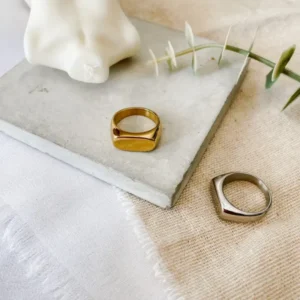The chevalier ring is a jewellery with roots in history. It is a beautiful accessory, but not only that: the chevalier ring is a symbol rich in meaning, whose roots go back to the ancient civilisations of Mesopotamia, where it was used as a symbol of noble distinction. The earliest rings that resemble modern chevalier rings can be dated back to around 3,000 BC. Often these jewels bore stamped stones – precious stones engraved with coats of arms, symbols or letters – or had a flat surface on which the engraved motif was placed. The chevalier ring was used in ancient times by royal families as a tool for authenticating important documents and initialing letters. It was sufficient to press it directly onto a sealing wax to imprint the family seal or symbol. Those who wore it showed the world that they belonged to royalty. Knights wore it from the day they were awarded their office until their death, and legend has it that when they breathed their last breath, the ring was destroyed.
The importance and further spread of the chevalier ring increased later in Ancient Egypt, where these jewels were worn not only by members of the nobility, but also by the Pharaohs themselves, to emphasize their prestige. The chevalier ring thus crossed several eras, reaching the Middle Ages, during which it became a symbol of the power and authority of an entire family and as such was passed down from generation to generation, from father to son. Medieval chevalier rings are recognized as important instruments for providing legal validity to contracts and all kinds of contracts.
The chevalier ring today
In modern times, the meaning of this ring has certainly changed. Today it is no longer used to emphasize that its owner belongs to an important lineage. A piece of jewelry once worn only by nobles and princes has become much more accessible over the years. Those who wear this ring do so to define their style and no longer to show their power to the world.
It retains its prestige and charm as jewelry, and while it used to be an exclusively male piece of jewelry, it has now become genderless, with jewelers proposing more and more models with different designs. The chevalier ring has never gone out of fashion, on the contrary, it always adds a touch of elegance and style to a sophisticated and distinctive outfit. Today, the chevalier ring is considered one of the most fashionable accessories for both men and women, and although it is no longer the symbol it once was, we can’t help but be captivated by its charm.
Chevalier ring: gold and other materials used
The typical chevalier ring is made of yellow, white or rose gold. Some examples have a flat head, ready to be engraved, while others are more sizable and pompous, but also decorated with gemstones of all kinds, sometimes covering the entire top.

Where should the chevalier ring be worn?
Many people who have never worn a chevalier ring may reasonably wonder on which finger of the hand it should be worn. At one time, this ring was worn by nobles – men only – on the little finger of their sovereign hand. The truth is that the chevalier is designed to be worn that way. The reason is that it is an important and often bulky ring, so wearing it on the little finger offers more comfort. With the advent of modern times, the use of this ring has changed. Today, women wear it on their little finger and men wear it on either the little or the ring finger. Since this ring is so personal, however, breaking this custom is by no means rare, with some people choosing to wear their chevalier ring on their index finger.
Chevalier rings and celebrities
Over the centuries, thousands of knights, nobles and aristocrats have worn a chevalier ring. Legend has it that Winston Churchill used to bang it hard on the arm of his chair in moments of nervousness, and the groove he created with the constant banging is still visible on his chair. While remaining in the United Kingdom, King Charles wore for decades a 180-year-old chevalier ring that originally belonged to Edward VIII, and bears the seal of the Prince of Wales. And other great figures of the recent past who used to wear this jewel were Steve McQueen, Frank Sinatra and Franklin Delano Roosevelt. Whether worn by knights, footballers, actors or influencers, the chevalier ring remains one of the jewels with the most significant symbolic value in the history of goldsmithing.


